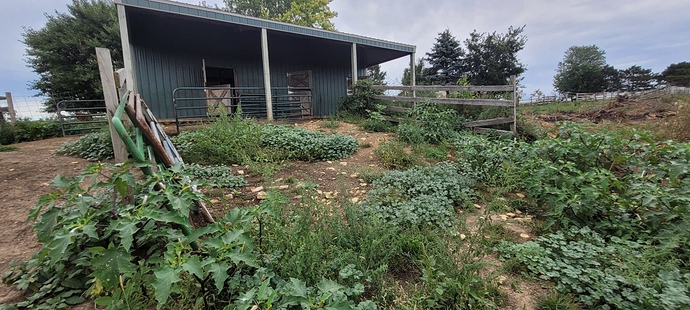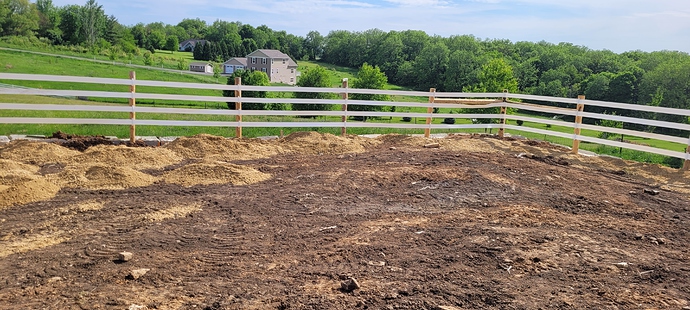Lighthoof also has links to some really good resources to help better understand drainage in general that are agnostic to their product. I haven’t had a need for their product but really appreciate their available education.
Thanks everyone. I took some photos, but because it’s overgrown with jimsonweed, kind of hard to tell right now. I’ll have to try and beat back the plants.
I have been reading through everything and some great ideas. A drainage plan is exactly the verbiage of what I was thinking about. A neighbor came over yesterday and thought there wouldn’t be enough room to hang gutters, but I was going to ask some of the companies what is exactly needed or if there’s another option.
There’s a very sharp delineation where the rain pours off the roof with a lot of rock exposed where the overhang is and it would be ideal to at least help mitigate some of that, rather than put down more footing and have it keep washing out.
The good news is my horses are at a great boarding barn. There’s no real rush (especially coming into a Midwestern winter) to get the horses home, so we want to plan out and do things correctly, rather than in a hurry and have to redo a lot of this in a year or two.
Yesterday’s adventure was just removing the four foot high by 10 foot wide bank of manure from inside the barn… I thought it was loose compacted hay, but it certainly was not, lol!
Ideally for gutters you want 2" overhang, so rain will fall in the gutters.
In the picture looks like you barely have 1/2", maybe 1".
Gutter companies have other ways to handle that, ask them what they suggest.
Gutters really help way more than we know before we use some.
Gutters can make a big difference. When we redid the barn, I had the contractor tilt them toward the southwest to prevent the icy spot that formed previously when they drained to the northwest.
A heads up that what is called jimson weed here is toxic to livestock, and its seeds are very persistent in soil. It has a weird odor and supposedly tastes bad, so usually not attractive to horses. But, I do my best to yank up any seedlings I see, because it would be just my luck that my horse would think it is a gourmet treat!
It’s definitely the same jimsonweed. It’s in part of the ‘drylot’ area that’s been destroyed by intense overgrazing, all the topsoil was stripped or ran off, so it basically turned into thistles and jimsonweed on top of a lot of bare rock.
I think we are taking a longer term approach to the worst area near the barn and rearranging fencing so we won’t have to use this area for a number of years and can work on eradicating the naughty plants and creating a better drainage plan on that side of the barn.
Can you use the area on the right of the picture as a swale to control/dissipate the run off? It looks like the water from beyond the shed naturally wants to be in that area, and the pitch of the shed roof also suggests that would be the best area.
In general, I’ve found that trying to work with the water is the easiest thing. You want to direct the water and then slow it down. I agree that a good drainage plan is needed, that is some pretty extreme erosion.
And good luck with the Jimson weed, ugh!
Good idea. It does naturally want to be in that area, but partially because the previous owners dug the trench to bring water and electric to the barn and never filled in the trench…so the low spot was the outside of the barn and there was the big mound of dirt off to the right (closer to the house).
But I think we are watching as it rains now and watching as now some of the big holes are filled in (ie the trench to the barn) and there was another giant hole on the backside of the house and see how the water continues to flow. We would like to essentially split it around to the left and the right of the barn and have enough land/drainage/etc to keep the soil in a better situation.
Plus, we have fewer animals. They had sheep, goats, horses, and a couple of ponies on it and I think it was a little too intense in that area. I think bringing soil back, a water plan, gutters, and just getting rid of the weeds will go a long way. That’s our hope anyway.
A lot of the rest of the property that was impassable due to thistles/weeds/debris has actually come back very well with just mowing, burning, and pulling out the worst offenders, so here’s to hoping.
Not sure of your location, but if you decide to spray the weeds, you need warm outside temps. The forage talks I have attended all recommend spraying at 80f or above. The plants absorb the spray better, faster, to have spray be more effective for you. Spraying at 50-60f is not going for do as much for you, since spray is much less ineffective on cold, non-absorbing plants.
Mowing is a great weed control, works in all temps! Ha ha I like to mow weeds that are 6-8 inches tall, which usually prevents them making seeds. Often the plant will use up his energy regrowing, never get seeds set this year.
We got in some new fill dirt that is full of Devils Trumpet, which is often sold as a garden flower. It is poisonous, so it MUST get removed from the pasture. It has very prickly seed pods, so definately needing heavy gloves on your hands. Then I have to haul the plants away to prevent seeds ripening and reseeding in place. Time consuming. Ground is too rough, stony to mow. I have to visit that spot every couple days to pull those weeds. They just keep appearing! Should be easier work now that rain has softened the dirt up.
The rest of the place is fairly weed free, due to regular mowing. My herbicides are mostly for keeping the fence rows clear. I sure timed spraying right, brown strips under the wires after 7 days! But I think we are done with 80f days, time to clean out the sprayers, get any liquid out to prevent freeze damage over winter.
Something not mentioned was using Geotextile fabric under fill, around or over any drain tile. It will help the fill, original soil, stay in place better when lots of water moves over the fill and fabric. . At our place, the fabric prevents stone or crushed concrete fill from disappearing into wet season, clay dirt. I can’t tell you how much fill “disappeared” before we found out about Geotextile fabric! You want the non-woven type. It is light, easy to cut with scissors, easy to place. Do wide overlaps because fabric can move when fill is put on top, leaving uncovered gaps.
Just wanted to update the work in progress.
I finally figured out someone to talk too which was the county soil erosion person. I managed to get her contact information when I was trying to find the right person to get low cost trees from the county : slight_smile:
Anyway, her recommendations are pretty spot on with what others suggested with primarily using large retaining wall structures to terrace the dry lot and to slope it off from there along with proper drainage, downspouts, etc.
So here is the work in progress so far tonight.
The drop between the barn and the fencing in the image was originally more than five feet. Still need more fill and I would like geotextile but have to water the money tree a bit.
Are you speaking of buried geotextile fabric sheets as a barrier like those used in French drains, or geotextile mixed into the soil like for arena footing?
The fabric or more likely the grids. I still need to bring in more fill and rock so could easily add another 6 inches on top of lighthoof or similar ag grid. 


